Stay Updated with Everything about MDS
Thank you! Your submission has been received!
Oops! Something went wrong while submitting the form.
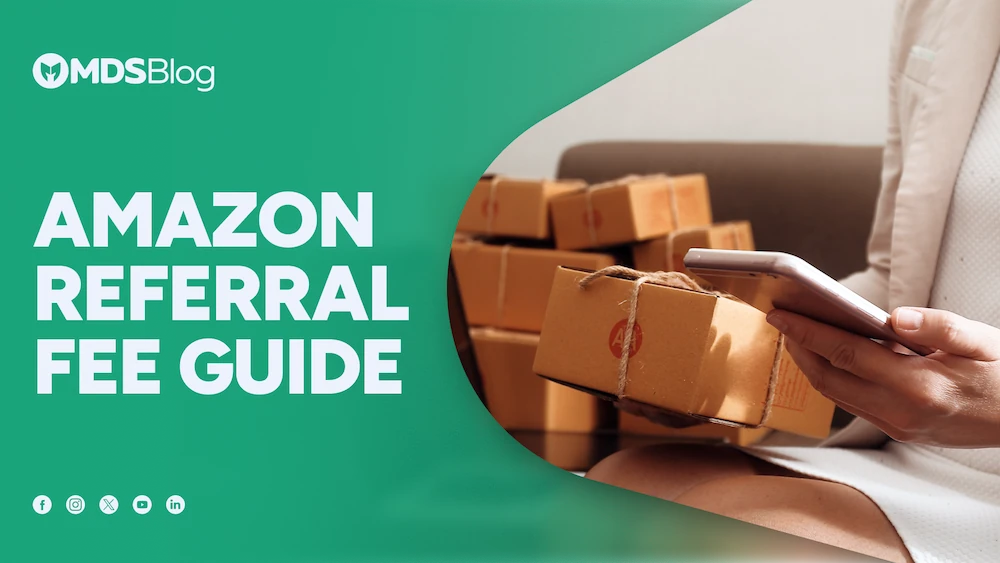
Chilat Doina
October 12, 2025
If you've ever sold anything on Amazon, you've seen the referral fee pop up on your payment reports. So, what exactly is it?
Think of it as Amazon's commission for every single sale you make on their platform. It’s the price of admission for getting your products listed in the world's biggest online store, putting you in front of millions of ready-to-buy customers. It's a fundamental cost of doing business on the marketplace, and you need to get your head around it.
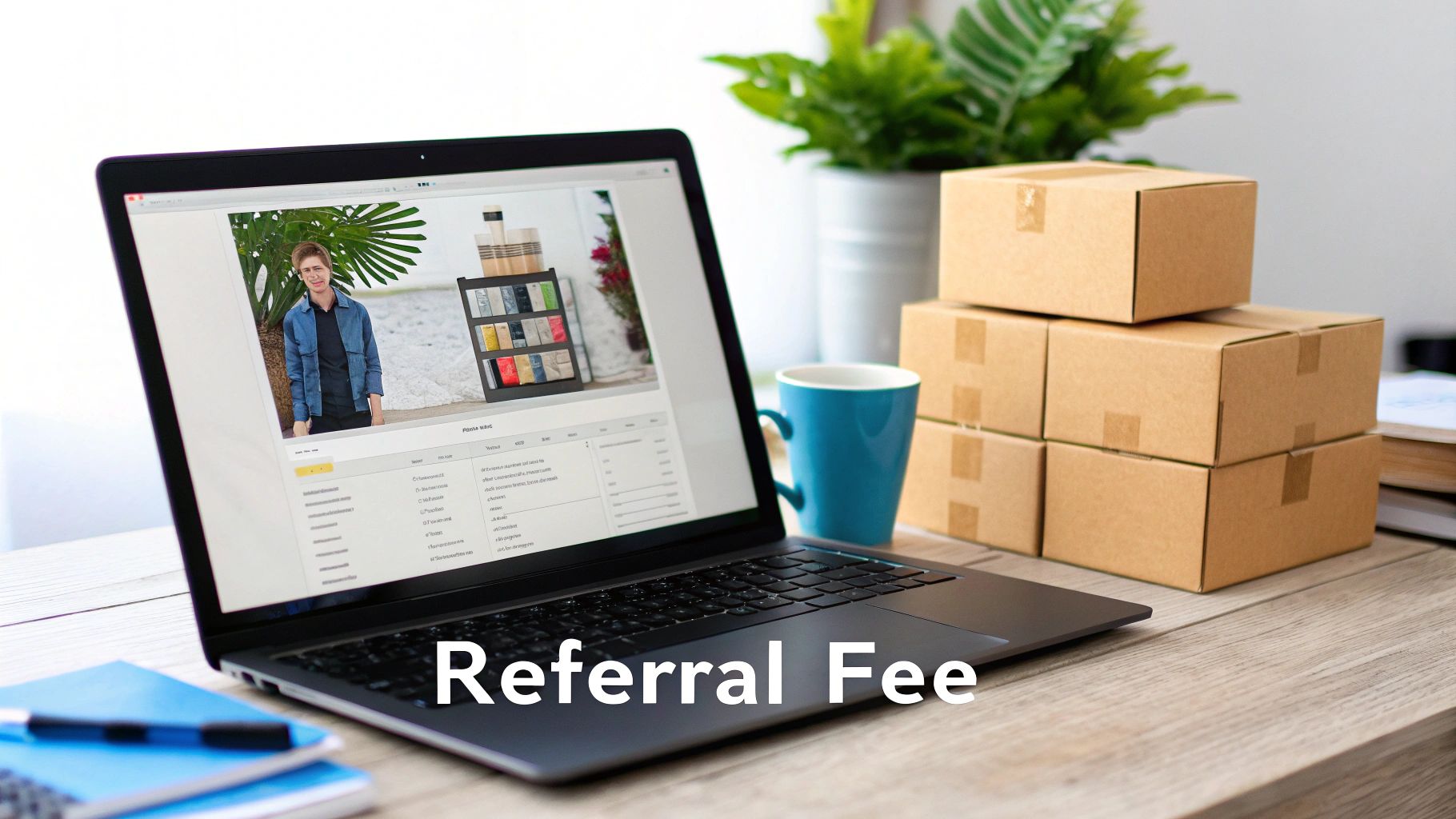
In short, the referral fee is Amazon's cut for "referring" a customer to your product. You're paying for the privilege of tapping into their enormous brand trust, their colossal customer base, and their rock-solid payment processing system. Honestly, trying to build that kind of traffic and infrastructure from scratch would cost a fortune in marketing and tech.
It’s really important not to mix this fee up with the other charges you'll see. It's completely separate from your monthly Professional seller subscription or the various Fulfillment by Amazon (FBA) fees that cover storage and shipping. The referral fee is a straight-up, per-item commission that only kicks in when you make a sale.
The Amazon referral fee is a core piece of your cost of goods sold (COGS) on the platform. If you get this wrong, your profit calculations will be off, your pricing strategy will be flawed, and you could be losing money from day one without even realizing it.
To help you get a clearer picture of where the referral fee fits in, here’s a quick breakdown of the main fees you'll encounter.
Fee TypeWhat It CoversHow It's ChargedReferral FeeThe commission for selling on Amazon's platform.A percentage of the total sale price, per item sold.Subscription FeeAccess to the Professional selling plan features.A flat monthly rate (e.g., $39.99).FBA FeesPicking, packing, shipping, and customer service.Per-unit fees based on item size and weight.Storage FeesStoring your inventory in Amazon's warehouses.Charged monthly, based on the volume your inventory occupies.
As you can see, the referral fee is unique because it's directly tied to your sales revenue, making it a variable cost you have to account for in every single transaction.
Here’s where it gets interesting: the percentage Amazon takes isn't a flat rate. It changes dramatically depending on the product category, which makes sense when you think about the different market dynamics and profit margins across industries.
We've seen referral fees range from as low as 6% to a staggering 45% of the total sale price. A classic example of a high rate is the Amazon Device Accessories category, which sits at that eye-watering 45% mark.
This means your profit margin on a book will be worlds apart from your margin on a new laptop, even if they both sell for the same price. It's a critical detail that trips up a lot of new sellers.
For a deeper dive into navigating the platform's financial side, our guide for Amazon FBA sellers is packed with valuable strategies. And if you want to understand how Amazon's ecosystem works in different regions, the Marketing Podcast on Amazon Australia episode offers some fantastic insights.
To have any shot at predicting your profits, you have to get inside the math behind Amazon’s referral fee. It’s not just a simple percentage of your item's price. Instead, Amazon takes its cut from the total sales price—basically, the final number a customer sees on their screen right before they click "buy now" (minus taxes).
This total sales price is built from three core pieces:
Think of it like a pie. Every slice contributes to the whole, and Amazon's fee is calculated on that whole pie, not just the main course.
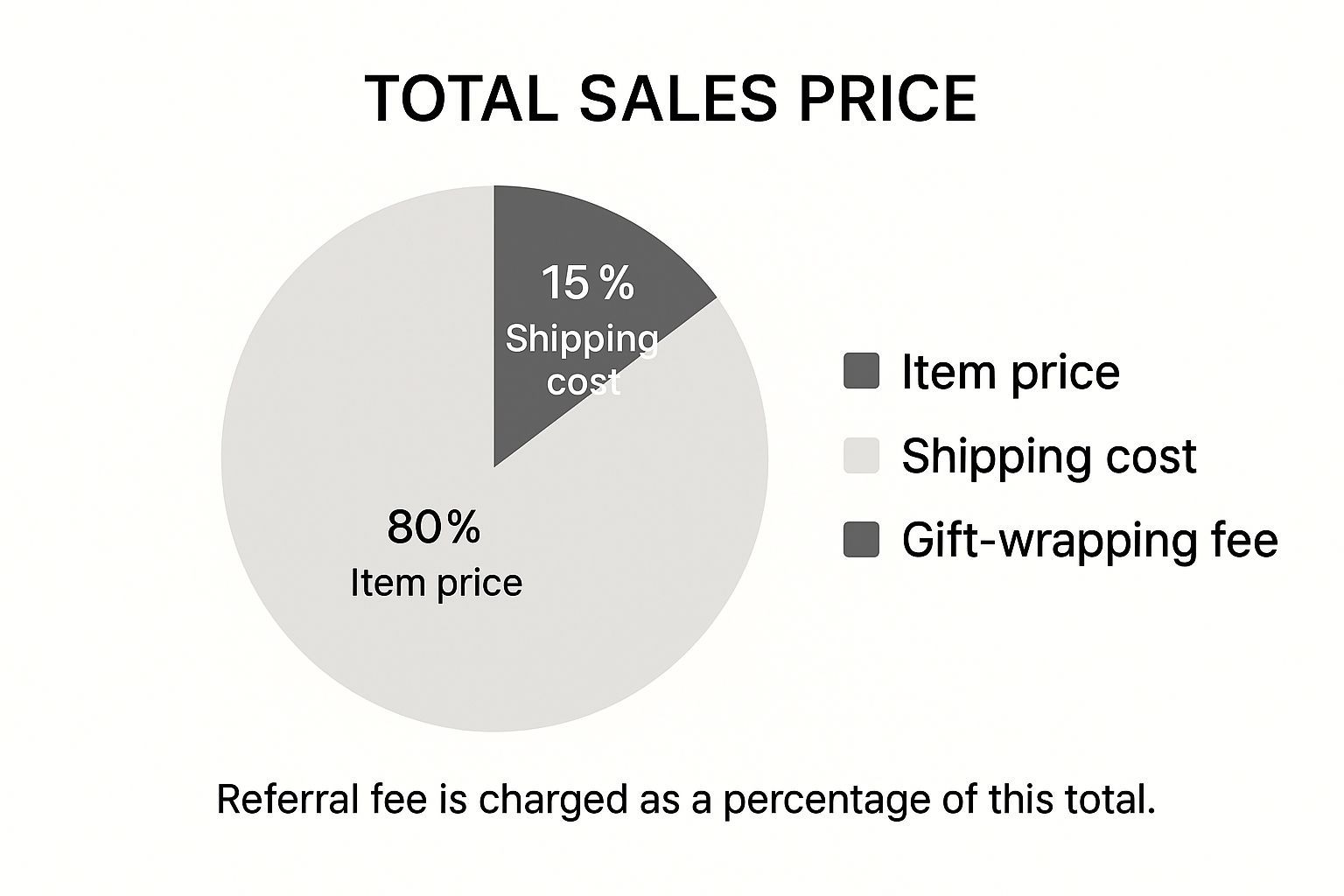
As you can see, every single dollar a customer pays—whether it's for your awesome product or the convenience of shipping and wrapping—gets added to the pot before Amazon calculates its commission. This is a super important detail, especially if you handle your own shipping. Those shipping charges you pass on to the customer? Yep, Amazon takes a piece of that, too. For a deeper dive into how this plays out, check out our guide on Amazon FBA vs FBM.
Just to keep things interesting, Amazon throws another layer into the mix: the minimum referral fee. For most categories, there’s a floor on how much Amazon will charge, and it's usually $0.30. The platform always charges you whichever is greater: the category percentage or that minimum fee.
Amazon's rule is simple: they take the bigger of the two. This really comes into play for sellers with low-cost items, where a percentage-based fee might only add up to a few pennies.
This setup guarantees Amazon makes a baseline commission on every transaction, no matter how cheap the item is. If you're selling things like books, small office supplies, or inexpensive accessories, this minimum fee can take a surprisingly big bite out of your already-thin margins.
Let's walk through a real-world scenario to make this crystal clear. Say you sell a fancy gourmet coffee scoop.
First, you need to find the total sales price by adding everything up:
$10.00 (Item) + $3.99 (Shipping) + $1.50 (Gift Wrap) = $15.49 (Total Sales Price)
Next, you apply the category percentage. Kitchen accessories fall under a 15% referral fee.
$15.49 x 0.15 = $2.32
Finally, you compare that number to the minimum fee. Since $2.32 is much greater than the $0.30 minimum, Amazon will take $2.32 as its referral fee for the sale. See? Every little pricing decision, from shipping to gift wrap, directly impacts the final fee you pay.
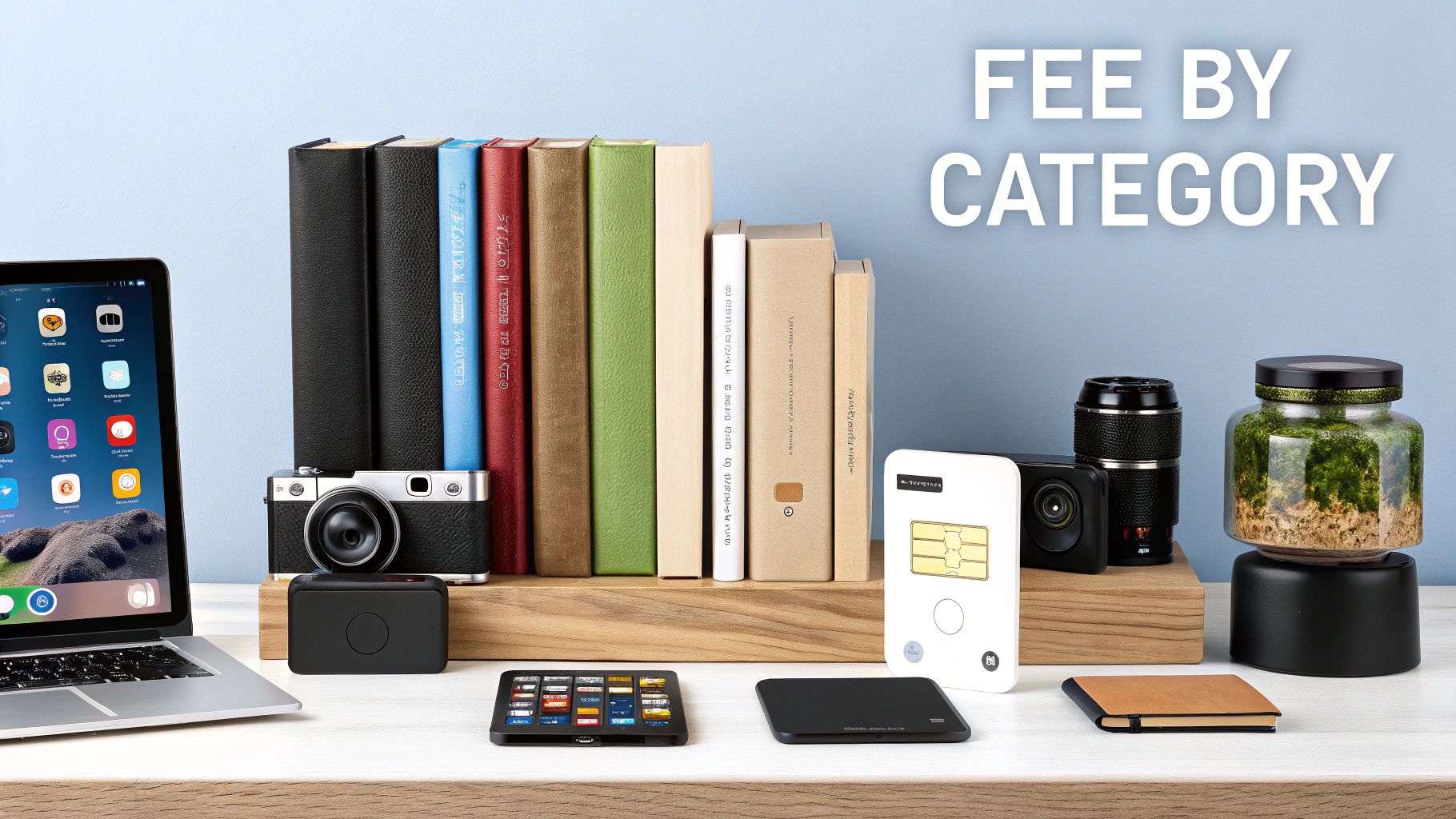
Not all products are created equal in Amazon's world, and the Amazon referral fee absolutely reflects that reality. The percentage you fork over is tied directly to your product's category, a single detail that can make or break your profitability from one item to the next.
This isn't some flat, one-size-fits-all charge. It’s a carefully designed system with rates that can be as low as 6% for things like personal computers or shoot up to a staggering 45% for Amazon Device Accessories.
Think of each category as a different storefront in a massive mall. A high-end jewelry boutique has a completely different cost structure than a high-volume grocery aisle. Amazon's fee schedule works the same way, setting commission rates based on the unique market dynamics of each product type. For any seller trying to build a real business on the platform, getting a handle on these differences is non-negotiable.
To give you a clearer picture, I've pulled together a table outlining the fee structures for some of the most common categories sellers operate in. This should help you quickly reference where your products might land.
Keep in mind, Amazon can and does update these rates. The golden rule is to always double-check the latest fee schedule in Seller Central before you lock in your pricing.
Product CategoryReferral Fee PercentageMinimum Referral FeeAmazon Device Accessories45%$0.30Books15%$0.30Clothing & Accessories17%$0.30Computers & Electronics8%$0.30Grocery & Gourmet Food8% (for items $15 or less)NoneGrocery & Gourmet Food15% (for items over $15)NoneHealth & Personal Care15% (for items $10 or less)$0.30Health & Personal Care8% (for items over $10)$0.30Home & Kitchen15%$0.30Jewelry20% on the first $250, 5% on the portion over $250$0.30Office Products15%$0.30Pet Supplies15%$0.30Sports & Outdoors15%$0.30Tools & Home Improvement15%$0.30Toys & Games15%$0.30
As you can see, that 15% figure is a common benchmark, but it’s far from the only rate. Venturing into different product niches reveals a much more complex fee landscape that you'll need to navigate carefully.
Just when you think you have it figured out, Amazon throws in another layer: tiered fee structures. For certain categories, the referral fee percentage actually changes based on the total sale price of an item. You'll see this most often with high-ticket products where a flat high percentage would scare sellers away.
Think of it this way: Amazon uses tiered fees to encourage sellers to list premium, higher-priced items. By lowering the commission on the portion of the price above a certain point, they make the platform more attractive for selling big-ticket goods.
Let's look at a couple of real-world examples to see how this plays out:
This tiered system is designed to reward higher average order values. If you know exactly where these price breaks happen, you can get strategic. You might adjust your pricing or create product bundles to push an item into a more favorable fee tier, which directly pads your profit margin on every single sale.
One thing you can count on as an Amazon seller is change. The marketplace is a living, breathing ecosystem, and its fee structure is no different. An Amazon referral fee isn’t set in stone; it’s a dynamic figure that can shift for a whole bunch of reasons.
Think of it like Amazon is steering a massive ship. They’ll adjust the sails—or in this case, the fees—to catch the best wind. They might be navigating new market conditions, responding to what competitors are doing, or trying to steer more growth into specific product categories.
These adjustments are just part of the game. Once you accept this, you can stop being surprised by changes and start anticipating them. This proactive mindset is what separates the sellers who thrive long-term from those who get squeezed out.
Your best defense against getting caught off guard is staying informed. Amazon is pretty good about communicating upcoming fee adjustments through official channels, and your home base for this information is always Seller Central.
Don't just glance at the announcements in Seller Central. Treat them like critical business intelligence. If you're regularly checking for news on fee changes, you can plug those numbers into your financial models and tweak your pricing before the new fees kick in.
If you look closely at Amazon's recent fee updates, you can start to see a clear strategy emerge. For example, they recently made targeted reductions to referral fees for low-priced apparel. That’s a clear signal they want to become even more competitive in a super high-volume category.
On the flip side, they've also announced periods of stability, promising no increases to certain fees to give sellers a more predictable cost structure. You can get a sense of their thinking by reading their official updates on Amazon’s fee strategy for 2025.
By keeping an eye on these trends, you get a peek into Amazon's playbook. A fee reduction in your category? That could be a green light to double down and push for growth. A fee increase? That’s your early warning to go back and re-evaluate your margins. It all comes back to being proactive. That's how you win in the ever-evolving world of Amazon fees.
While Amazon’s referral fee is a non-negotiable cost of doing business on the platform, you absolutely have the power to lessen its sting. Think of it less as a fixed, unavoidable deduction and more as a variable you can influence with smart, strategic decisions.
Instead of just shrugging and accepting the fee as-is, the savviest sellers get proactive. The key is to zero in on the numbers you can control—things like your pricing, how you present your products, and your operational efficiency. A few small tweaks here and there can compound over time, leading to a much healthier bottom line.
One of the most effective plays in the seller's handbook is product bundling. By grouping complementary items into a single package, you naturally increase the average order value (AOV) for each transaction. For instance, instead of just selling a coffee scoop for $8, why not bundle it with a bag clip and a cleaning brush and sell the set for $15?
This move is especially powerful for lower-priced items that are in danger of getting hit with that pesky $0.30 minimum referral fee. A smart bundle can easily push the total sale price high enough to bypass the minimum, meaning the standard percentage fee applies instead. In many cases, this simple shift can instantly improve your unit economics.
Never, ever underestimate how much product categorization matters. A simple oversight here can be an incredibly costly mistake, as referral fee percentages can vary wildly from one category to the next. Accidentally listing a kitchen gadget under "Electronics," for example, could mean you're paying a completely different—and likely much higher—fee than you need to.
Always double-check and triple-check that your products are listed in the most accurate category possible. This isn't just about following Amazon's rules; it's a direct lever you can pull to make sure you're not overpaying on referral fees.
This one simple act of verification can save you hundreds, if not thousands, of dollars over the course of a year. It’s one of the easiest ways to protect your profits without having to change a single thing about your product or its price.
Finally, let your data be your guide. Your pricing strategy has to account for the referral fee from the get-go. Before you even list a product, use Amazon’s own fee calculator or other third-party tools to model your profitability at different price points. This kind of foresight is what keeps you from launching a product that's already unprofitable on day one.
Beyond just understanding the fee structure, consistent and accurate tracking business expenses is absolutely vital. You should be regularly digging into your sales reports to see which of your products have the healthiest margins after all of Amazon’s fees have been taken out.
For a deeper dive into optimizing your financial health, check out our guide on how to improve gross margins. This data-driven approach is what allows you to focus your ad spend and inventory investment on the products that are truly pushing your business forward.
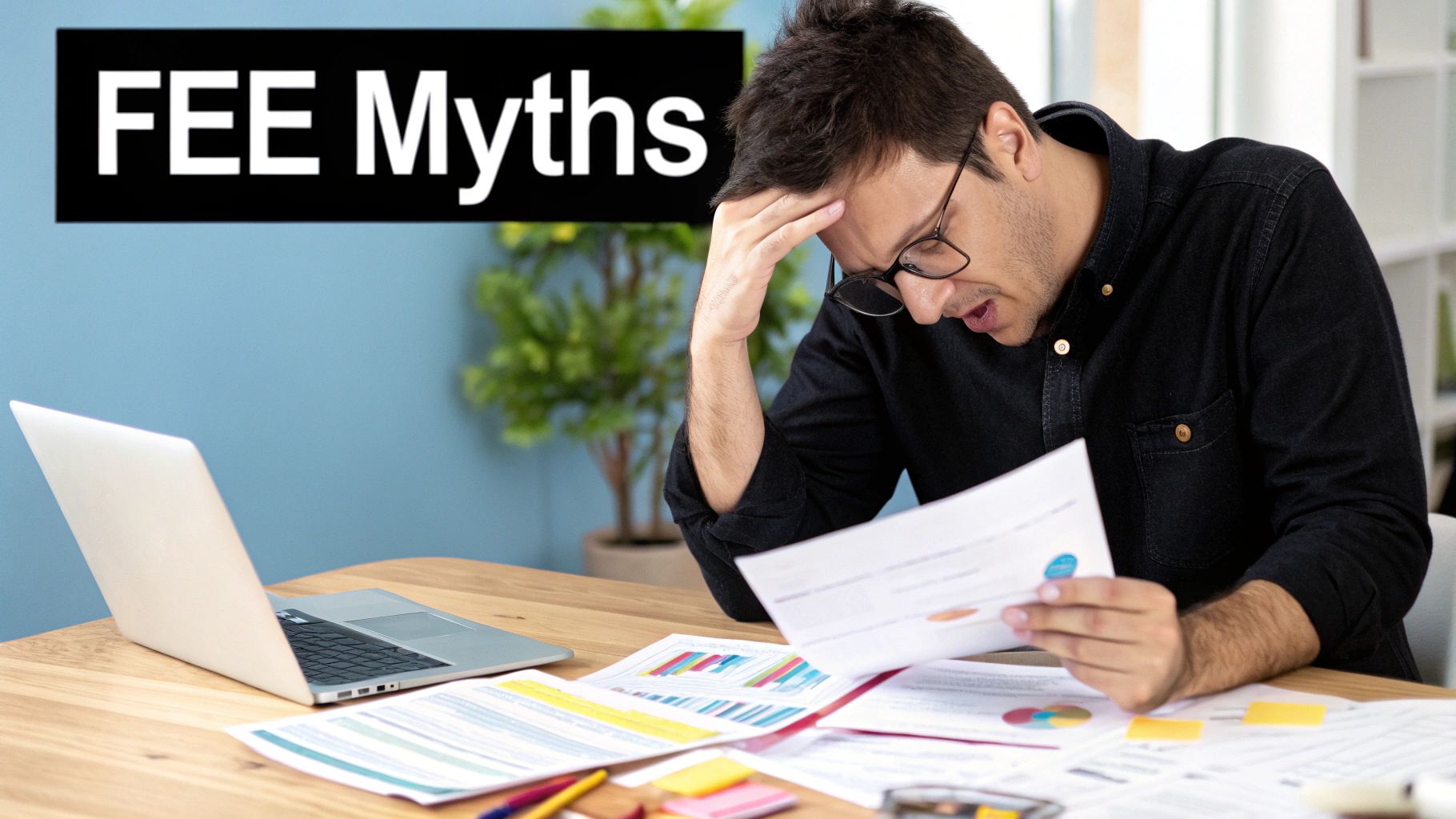
If you've spent any time selling on Amazon, you know the fee structure can feel a bit like a maze. It’s easy to get turned around, and a few common points of confusion trip up sellers all the time. Getting these details wrong can seriously eat into your profits, so let's clear the air on the biggest misconceptions right now.
The most frequent mix-up? Confusing the referral fee with Fulfillment by Amazon (FBA) fees. They aren’t the same thing—not even close. The referral fee is Amazon's sales commission, while FBA fees cover all the logistics of getting your product to the customer.
Think of it like this: The Amazon referral fee is your payment for getting access to the shelf space in Amazon's massive digital store. The FBA fee is what you pay for Amazon's team to grab your product off that shelf, box it up, and ship it.
Nailing this distinction is everything. Your referral fee is a slice of your revenue, a cost of making a sale. FBA fees, on the other hand, are purely operational costs tied to the physical side of your business.
Here's another classic mistake: thinking the referral fee is only calculated on your item's price. It's not. Amazon calculates the fee based on the total amount the customer pays, which includes the item price, shipping charges, and any gift-wrapping fees.
Sellers who fulfill their own orders (FBM) are often shocked when they realize Amazon is taking a cut of the shipping revenue they collect. It's a critical detail to get right if you want your profit calculations to be accurate.
Let’s bust a couple of final myths so you're operating with a crystal-clear understanding of the rules of the road.
First, Amazon referral fees are set in stone. They're non-negotiable. The rates are fixed by category and apply to every single seller, whether you're selling ten units a month or ten thousand.
Second, what about returns? When a customer sends an item back and you issue a full refund, Amazon gives you back the referral fee you paid. But there’s a small catch—they keep a tiny portion of it as a "refund administration fee." It’s a minor detail, but one you need to account for in your bookkeeping.
As you get the hang of Amazon's fee structure, a few specific questions always seem to pop up. Let's tackle some of the most common ones sellers ask about referral fees.
Nope, you’re in the clear on this one. The referral fee is a commission, and a commission only gets paid when a sale actually goes through.
If an order gets canceled—either by you or the customer—before you ship it, the transaction is void. No sale, no fee. It never even hits your account.
This is a great question. When a customer sends something back and you process a full refund, Amazon gives you back the referral fee you paid for that sale.
But there’s a small catch. Amazon keeps a tiny slice of the original fee, which they call the Refund Administration Fee. It's the lesser of $5.00 or 20% of the referral fee. It’s not much, but it’s a detail you'll want to track in your accounting.
In a word: no. Amazon’s referral fees are non-negotiable. The rates are locked in by category and apply to every single seller on the platform, whether you're a seven-figure brand or just getting started.
Instead of trying to negotiate the rate, your energy is much better spent on smart strategies to lessen its impact. Think about things like strategic pricing, product bundling, or just double-checking that your products are in the right (and cheapest) category.
Absolutely not, and getting this wrong can really mess up your numbers. It’s a critical distinction.
Think of it this way:
One is a sales commission, the other is a service fee for fulfillment. They're two completely separate costs.
At Million Dollar Sellers, we know that truly mastering your numbers is what separates the good sellers from the great ones. Our exclusive community is built to give you the high-level strategies and peer support you need to turn complexities like referral fees into a competitive advantage and build a massively profitable brand. Join the top 1% of e-commerce entrepreneurs and start scaling smarter.
Join the Ecom Entrepreneur Community for Vetted 7-9 Figure Ecommerce Founders
Learn MoreYou may also like:
Learn more about our special events!
Check Events